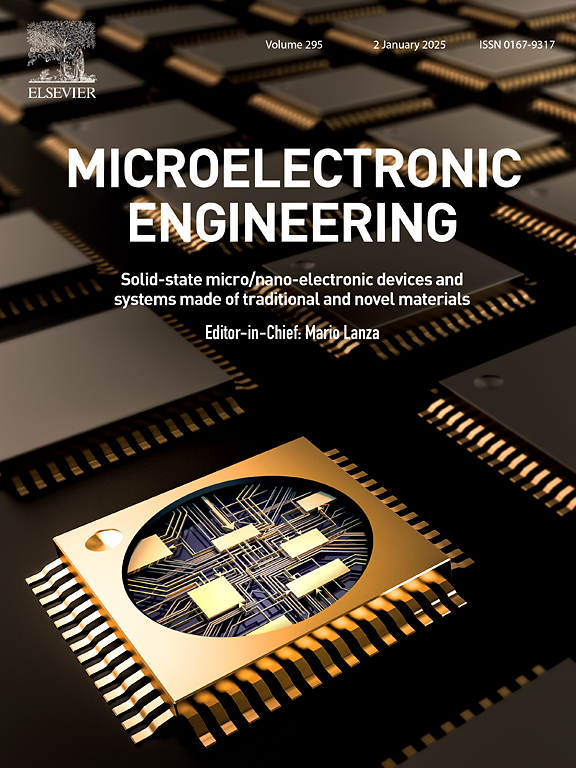Methodology for data retrieval of MRAM: Technological analysis, sample preparation and internal electrical measurements
IF 3.1
4区 工程技术
Q2 ENGINEERING, ELECTRICAL & ELECTRONIC
引用次数: 0
Abstract
This paper presents the methodology to be applied in order to achieve the data retrieval of any magneto-resistive random access memory (MRAM) on the market, whether it's a Toggle MRAM or a STT-MRAM. This methodology consists of four stages: theoretical study of the structure, technological analysis to identify the physical structure of the memory, preparation of the memory to make the data accessible, and readout of those data.
Knowing the structural elements and how the MRAM is read/written allows the possibility to do its technological analysis. Then, this analysis allows the identification of the magnetic tunnel junction (MTJ), where the data (‘0’ / ‘1’) is stored as resistance states, and of its surroundings, mainly the bitline. Once this is done, a complex preparation of the device's backside is achieved to expose both sides of the MTJ: one side to apply the voltage and the other to collect the current. The sample preparation methodology consists of a chemical opening, a polishing down to the transistors, focused ion beam (FIB) etches of metallization levels surrounding the MTJ and metal deposition. Finally, the memory can be read by techniques derived from atomic force microscopy (AFM). For both memory types, the discrimination of the bit states is proved by conductive AFM (C-AFM).
This work demonstrates that it is possible to retrieve data stored in a Toggle MRAM (130 nm technology node) and in a STT-MRAM (40 nm technology node) using invasive techniques. These components thus represent the two types of MRAM on the market, with classical and more advanced technology nodes. The data readout validates the sample preparation flow.

MRAM数据检索方法:技术分析、样品制备和内部电测量
本文提出了用于实现市场上任何磁阻随机存取存储器(MRAM)的数据检索的方法,无论是切换MRAM还是STT-MRAM。该方法包括四个阶段:结构的理论研究,技术分析以确定存储器的物理结构,准备存储器以使数据可访问,以及读取这些数据。了解结构元素以及MRAM是如何读/写的,可以进行技术分析。然后,该分析允许识别磁隧道结(MTJ),其中数据(' 0 ' / ' 1 ')存储为电阻状态,以及其周围环境,主要是位线。一旦这样做了,器件背面的一个复杂的准备工作就完成了,以暴露MTJ的两侧:一边施加电压,另一边收集电流。样品制备方法包括化学开孔、抛光至晶体管、聚焦离子束(FIB)蚀刻MTJ周围的金属化水平和金属沉积。最后,可以通过原子力显微镜(AFM)技术读取存储器。对于这两种类型的存储器,通过导电AFM (C-AFM)证明了比特状态的鉴别。这项工作表明,可以使用侵入性技术检索存储在Toggle MRAM (130 nm技术节点)和STT-MRAM (40 nm技术节点)中的数据。因此,这些组件代表了市场上两种类型的MRAM,具有经典和更先进的技术节点。数据读出验证样品制备流程。
本文章由计算机程序翻译,如有差异,请以英文原文为准。
求助全文
约1分钟内获得全文
求助全文
来源期刊

Microelectronic Engineering
工程技术-工程:电子与电气
CiteScore
5.30
自引率
4.30%
发文量
131
审稿时长
29 days
期刊介绍:
Microelectronic Engineering is the premier nanoprocessing, and nanotechnology journal focusing on fabrication of electronic, photonic, bioelectronic, electromechanic and fluidic devices and systems, and their applications in the broad areas of electronics, photonics, energy, life sciences, and environment. It covers also the expanding interdisciplinary field of "more than Moore" and "beyond Moore" integrated nanoelectronics / photonics and micro-/nano-/bio-systems. Through its unique mixture of peer-reviewed articles, reviews, accelerated publications, short and Technical notes, and the latest research news on key developments, Microelectronic Engineering provides comprehensive coverage of this exciting, interdisciplinary and dynamic new field for researchers in academia and professionals in industry.
 求助内容:
求助内容: 应助结果提醒方式:
应助结果提醒方式:


